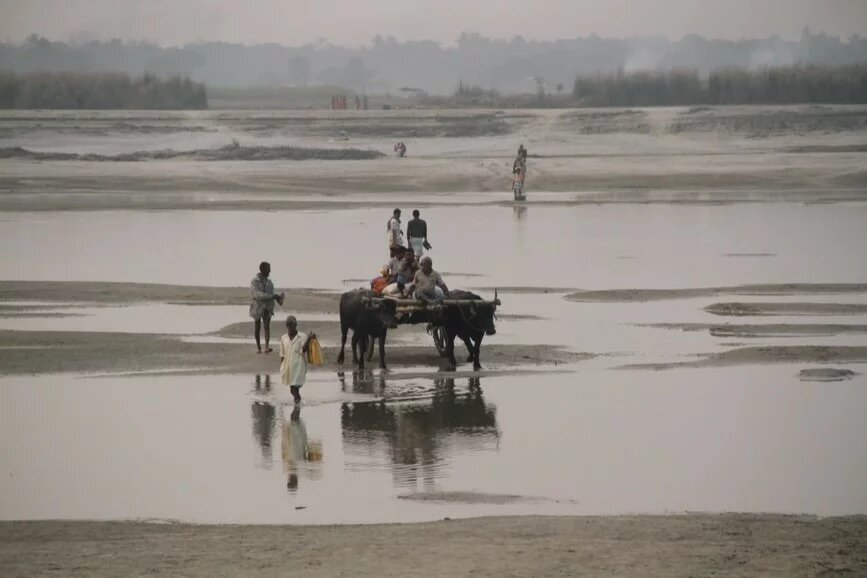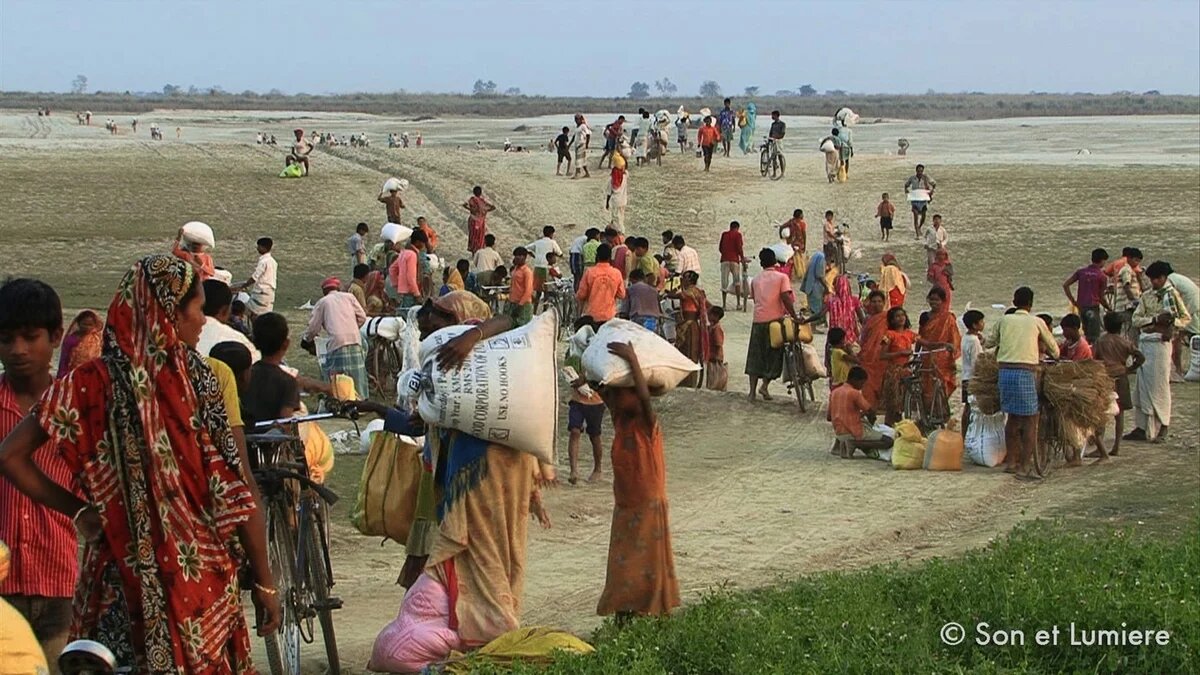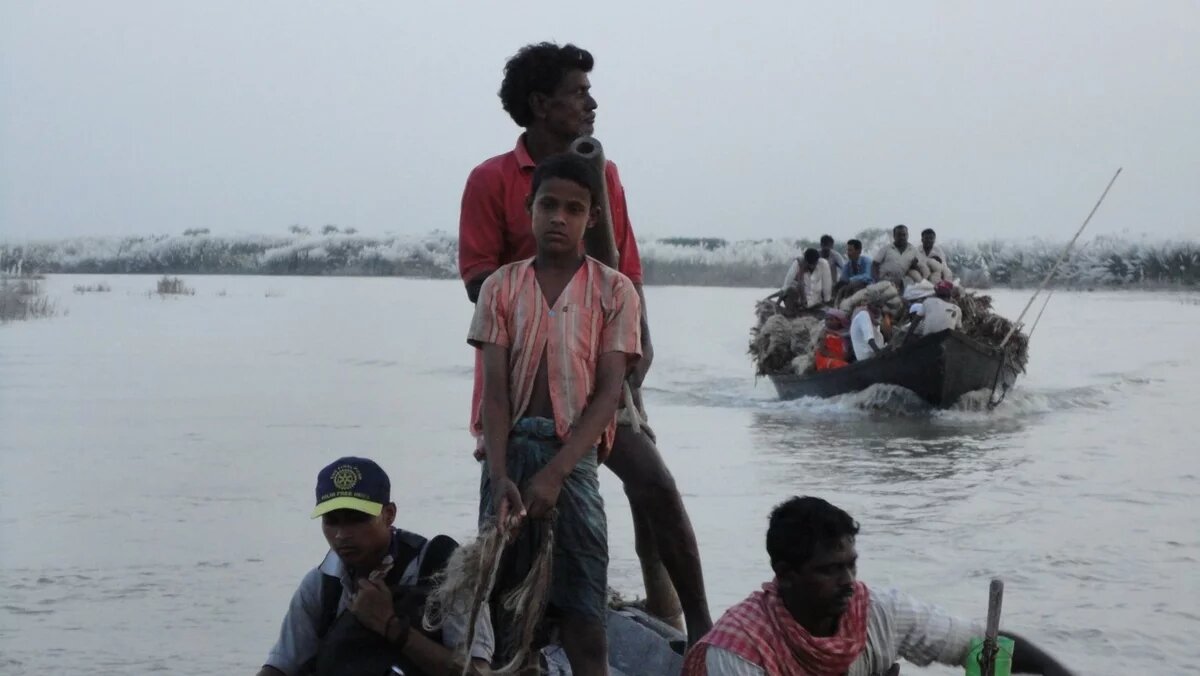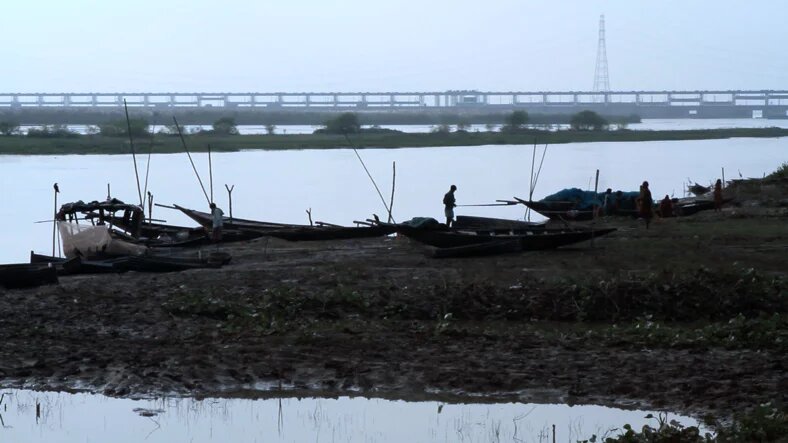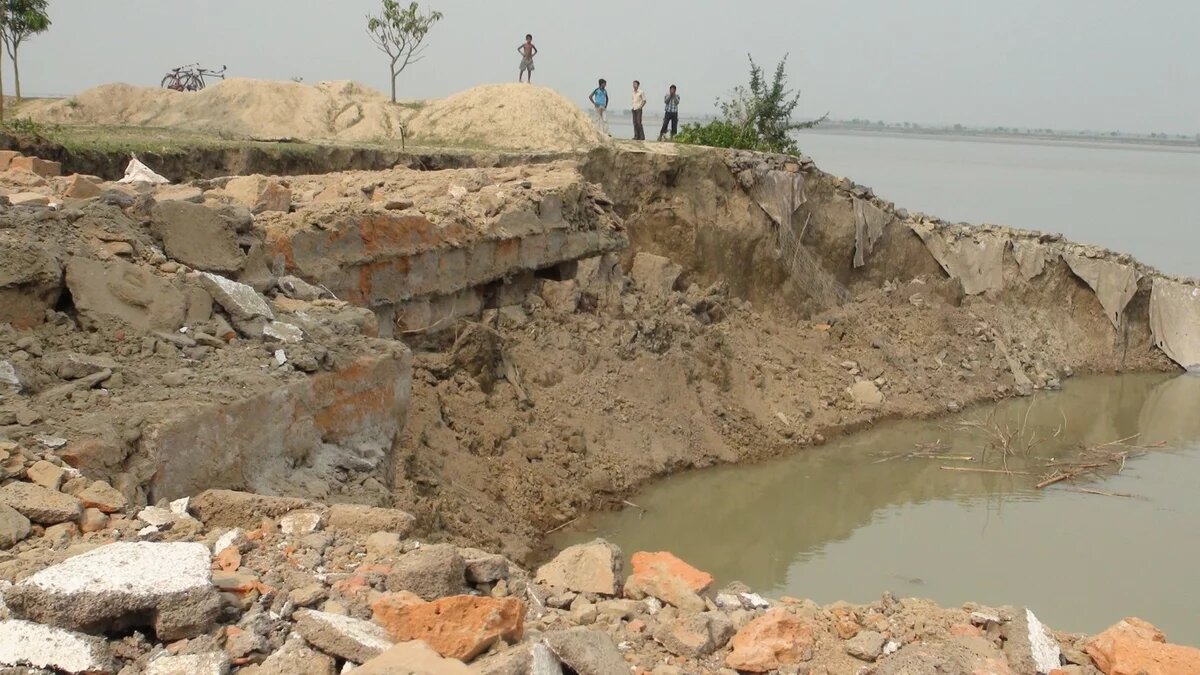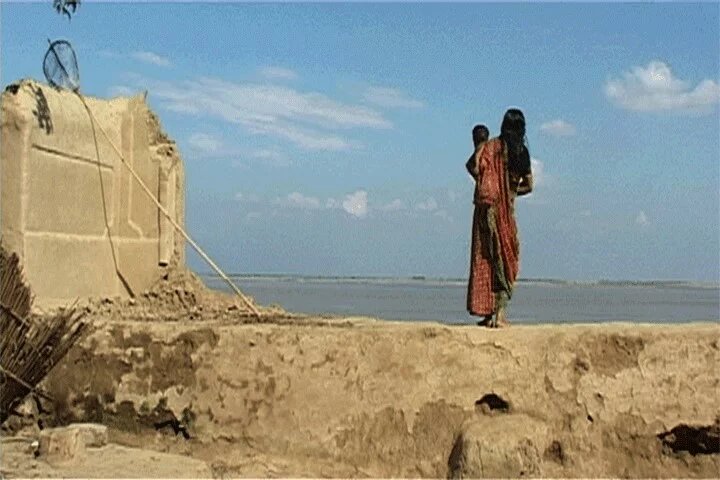
Human intervention in the course of the river Ganga is increasingly leading to erosion, flooding and landslides in the border region between India and Bangladesh. Local residents on the banks of the river often lose their land, their homes and their livelihoods as a result. Instead of support, those affected experience persecution and criminalization because they are forced to settle on islands in the no man's land between the two countries and to live from smuggling.
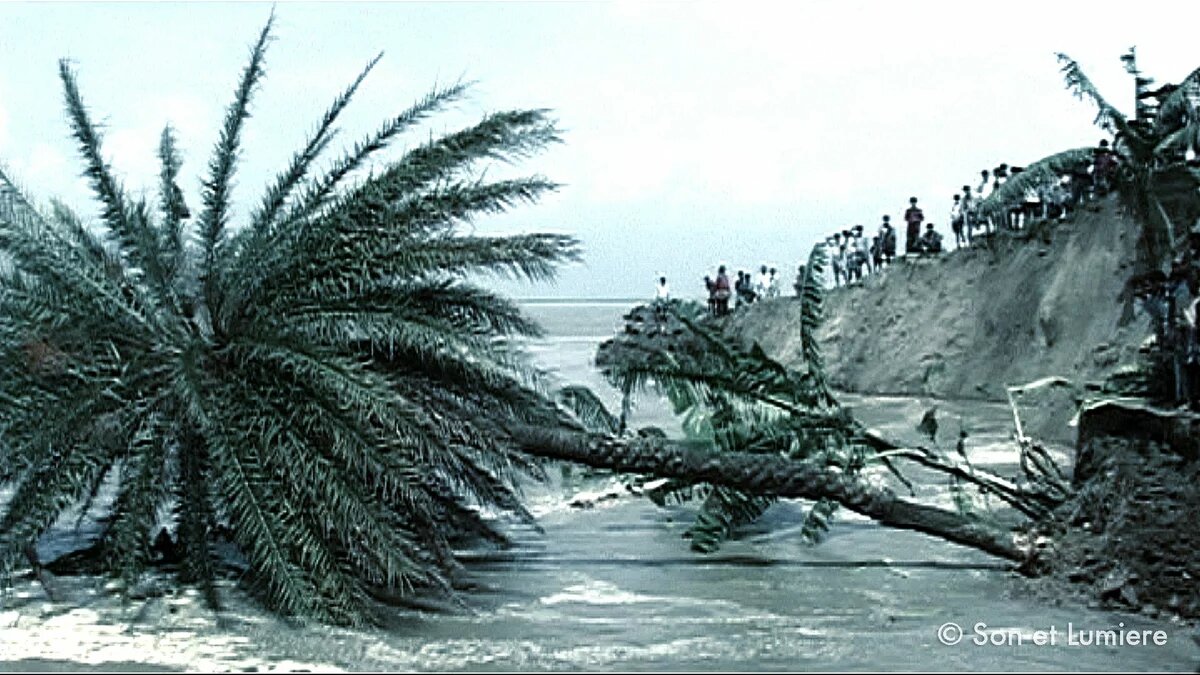
In India, the Ganga River is revered as a goddess and seen as a benevolent mother who brings sweet water on the earth, like the elixir of life, from the Himalayas, the divine abode. But what happens when these sacred myths clash with reality, and millions are left homeless by her destructive force?
Holding a movie camera in my hand, I’ve spent years witnessing scenes reminiscent of Lord Shiva’s dance of destruction, who was also Ganga’s consort. The ground beneath me cracked open, white foam swirled on the water, and ravens cawed harshly as they feasted on worms emerging from the earth. Houses, orchards, trees, mosques, shops and graveyards vanished before my eyes in a slow-motion apocalypse. Within hours, an entire village met its watery grave in the eroding river.
The ground beneath me cracked open, white foam swirled on the water, and ravens cawed harshly as they feasted on worms emerging from the earth.
Along her 2,500-kilometer journey to meet the Bay of Bengal, I travelled just a hundred kilometres as she enters the Bengal basin, freshly released from the Rajmahal hills in Eastern India. Here, joined by her many tributary ‘sisters,’ the Ganga behaves like a pregnant woman, heavy with the burden of silt, which she spreads to create one of the most fertile lands on Earth, teeming with human life.
Here the river meanders with a slow, deliberate grace. In winter, she thins out, exposing her bare banks, only to swell and flood them during the monsoons. The people who live by her side—the river people—have understood her moods for generations, living in harmony with her ever-changing nature.
But now, the ‘river people’ stand confused and helpless as Mother Ganga slowly devours the very land she once created. Their bewilderment leads to chaos because, when India declared independence from British rule in 1947, the midpoint of the river was drawn as the international boundary between East Pakistan (now Bangladesh since 1971) and India. Borders can not move but the river does, so do her people. But where will they go?
More confusion reigns as fragile islands of sand and silt, known locally as 'chars,' emerge in the middle of the river every few years. Homeless people from both sides of the border settle on these new floating lands, believing they belong to them. Having lost their homes, farmlands, and livelihoods, they have spent years living as refugees in their own country, in roadside shanties. Some have been driven to madness, others have disappeared without a trace, but many of them survived, clinging to the hope that the state will one day recognize their plight as legitimate voters with human rights.
However, the politicians they once empowered with their votes turned their backs, citing the Indian constitution’s lack of provisions for aiding victims of river erosion. Left with no other choice, the people moved to char islands claiming that the soil belongs to them, for which they pay taxes.
But, the char islands become No-Man’s Land between two countries where no one is allowed to stay or even visit. By living there illegally, one loses citizenship, the most perilous fate in the porous borderlands one can imagine.
One doesn't just lose their identity by settling in a char; they also lose their livelihood. Without any basic amenities like roads, electricity, health centres, schools, or any infrastructure, the easiest way to survive is to get involved in border crimes. The river people, who once cultivated the fertile lands of the Gangetic floodplains, rowed boats, caught fish, or traded, have now become smugglers. The most profitable and dangerous item to smuggle is cattle. But why cattle? It's simple. In Bangladesh, a Muslim-majority country, beef consumption is higher than in India, where the majority Hindu population considers cows sacred and doesn't eat beef.
The river people, who once cultivated the fertile lands of the Gangetic floodplains, rowed boats, caught fish, or traded, have now become smugglers.
The next smuggled item is even more surprising—'Phensedyl,' an Indian-made cough syrup; they call it 'Dil.' But why is a cough syrup in high demand? Do Bangladeshis catch cold easily than others do? No, in Bangladesh, alcohol is banned under Islamic law, but this cough syrup contains a small amount of alcohol to make one ‘high’. Women smuggle 'Dil' by hiding bottles under their sarees. The border police, who are mostly men, cannot touch women’s bodies, making it easier for them to smuggle the bottles.
Carrying sacks of rice on bicycles, the only means of transport, is a common sight because rice sells for a higher price across the invisible border. Depending on the price, it could be onions, sugar, or even garlic. The more sophisticated rackets smuggle gold and firearms. Even more disturbingly, they traffic humans for various purposes. Gunshots frequently break the night's silence, as both border police and mafia gangs are well-armed with explosives and firearms. The civil police have no jurisdiction in the 'No-Man’s Land,' making char islands a safe haven for criminals who take temporary refuge from the mainland as if they were on holiday.
At first glance, the char islands seem calm and serene, but getting there is no easy task. I often smuggled myself in with the locals or managed to secure permission from the police headquarters by using some journalistic tricks. On the surface, it looks like any ordinary Indian village, but the truth reveals itself the longer you stay, peeling back layer after layer like an onion.
Many questions haunted me while I was in the char and even more after I returned.
Who is responsible for branding these river people as criminals? Why must children learn how to bribe the police with a bottle of rum instead of attending school? How did some of the most fertile lands on earth become human wastelands along the Ganga, the most magical and majestic river of the south?
And the big question, why did the Ganga river start eroding her banks so fiercely and unpredictably in two specific districts of West Bengal, namely Malda and Murshidabad In recent history?
I will share what the village head told me in his own words. Though he lost his eyesight long ago, his vision remained sharp. "Sonny, everything in the universe has its own rhythm. In our land, the river moves like a snake, leaving a zigzag trail. But if you catch a snake by its neck, its tail will thrash violently. You city folk caught Mother Ganga by her neck at Farakka with a fork made of iron and steel. So, she turned into a venomous snake, trying to free herself from your grip."
As you read this, you might recall the many debates from the past, including those surrounding the construction of the Farakka Barrage in the 1970s to control the water flow between two nations. Those debates evolved into bitter and complex geopolitical negotiations that continue to strain international relationships even today.
With today's advanced technology, including AI, we have the means to manage our resources more effectively. I checked satellite images of the region taken over decades. It is clear that the river's course changed much faster after the barrage was built, rendering thousands homeless destitute.
Natural disasters are intensifying worldwide as humanity's attempts to control nature. Who truly owns the Earth?
I recall the blind old man during my final trip to the char, sitting in the fading light, sipping tea, and talking quietly. He said, "We belong to the river, not the other way around." His words echo in my mind, a poignant reminder of the deep connection between humans and nature, a bond we often forget in our quest for control.
The author is an award winning film maker from India. The author is an award-winning filmmaker from India. You can watch his film, which was shot in the border region between India and Bangladesh, here:
CHAR… the No-Man’s Island – Sourav Sarangi - Orient Indie Films
Watch on Vimeo
